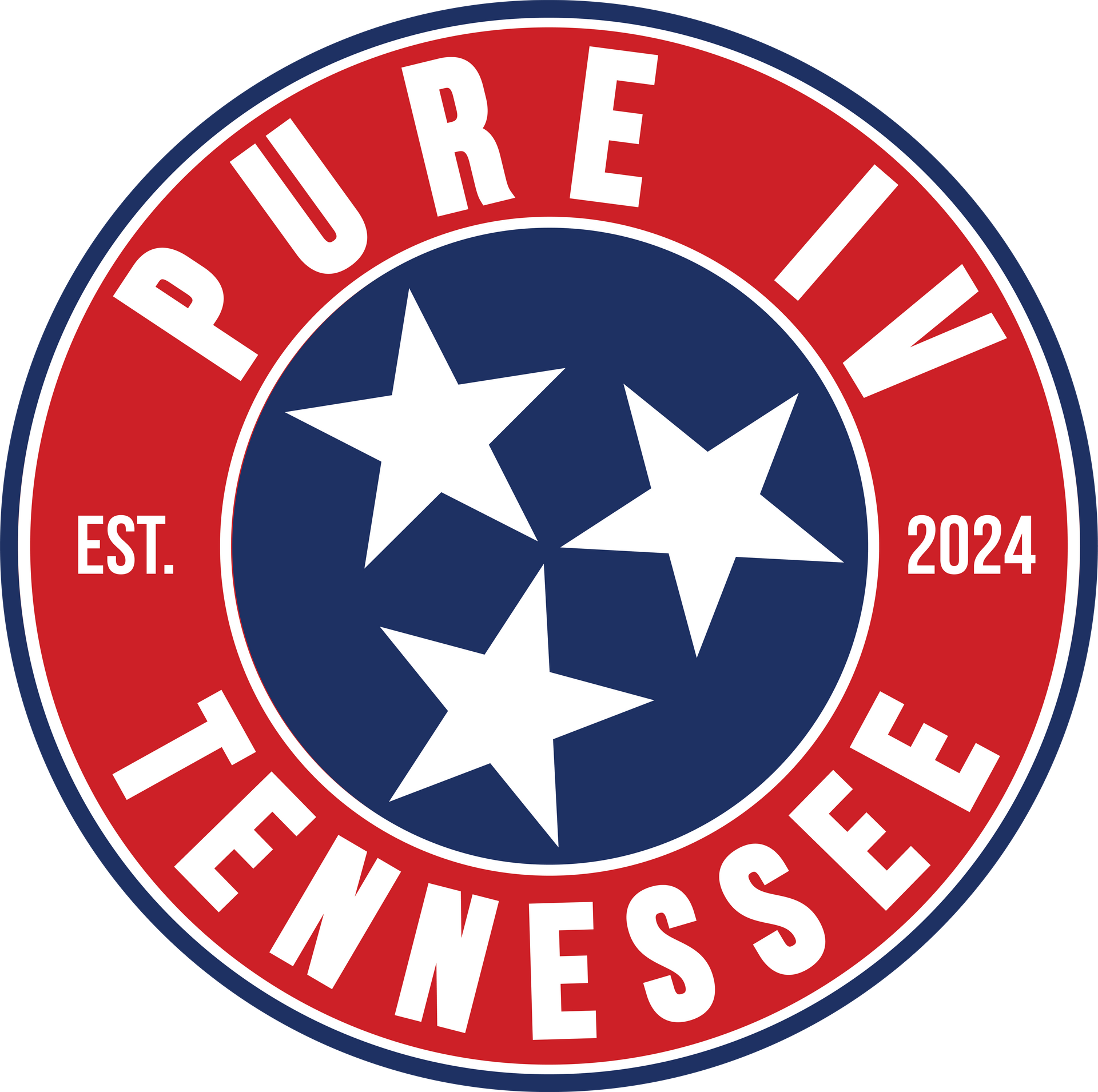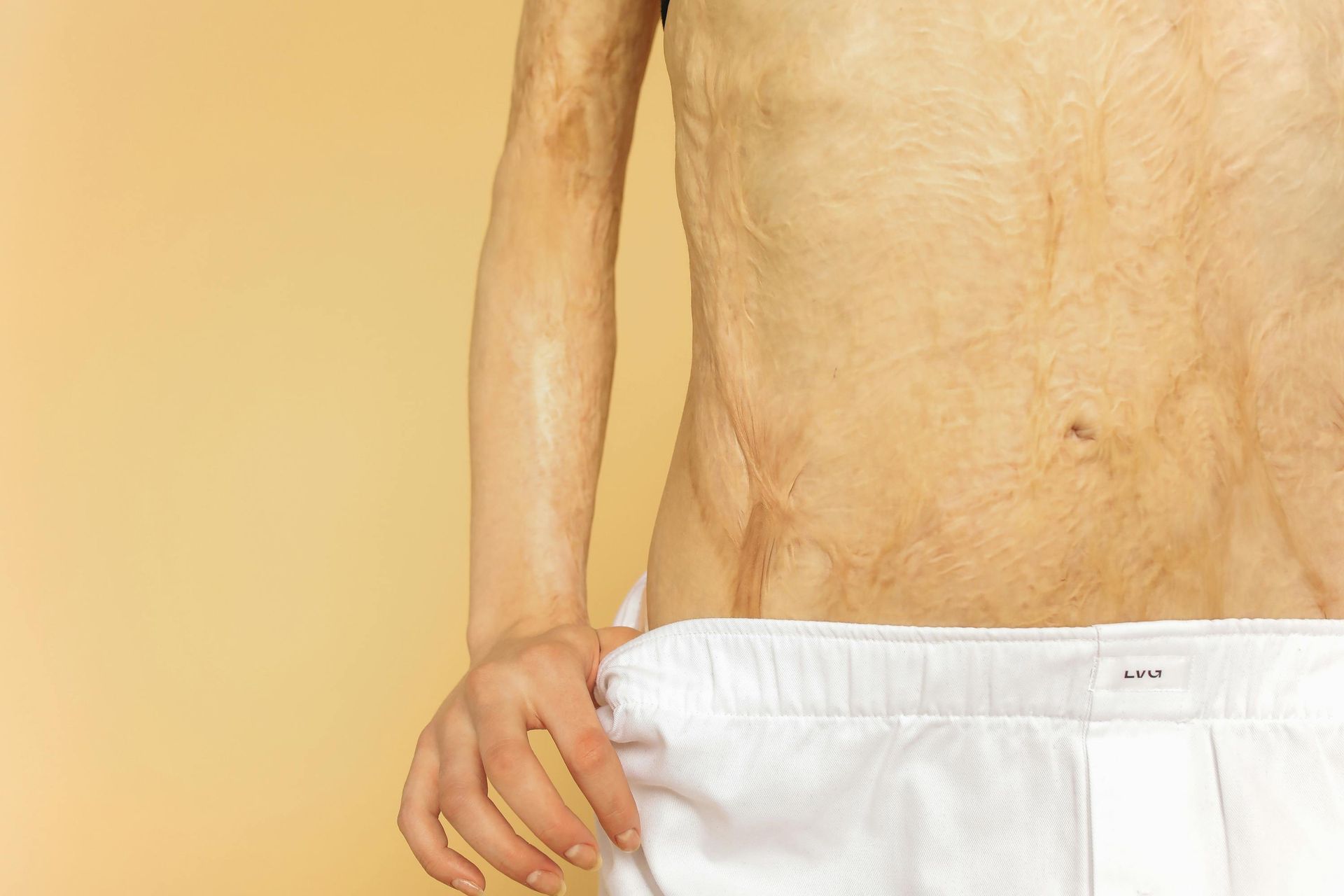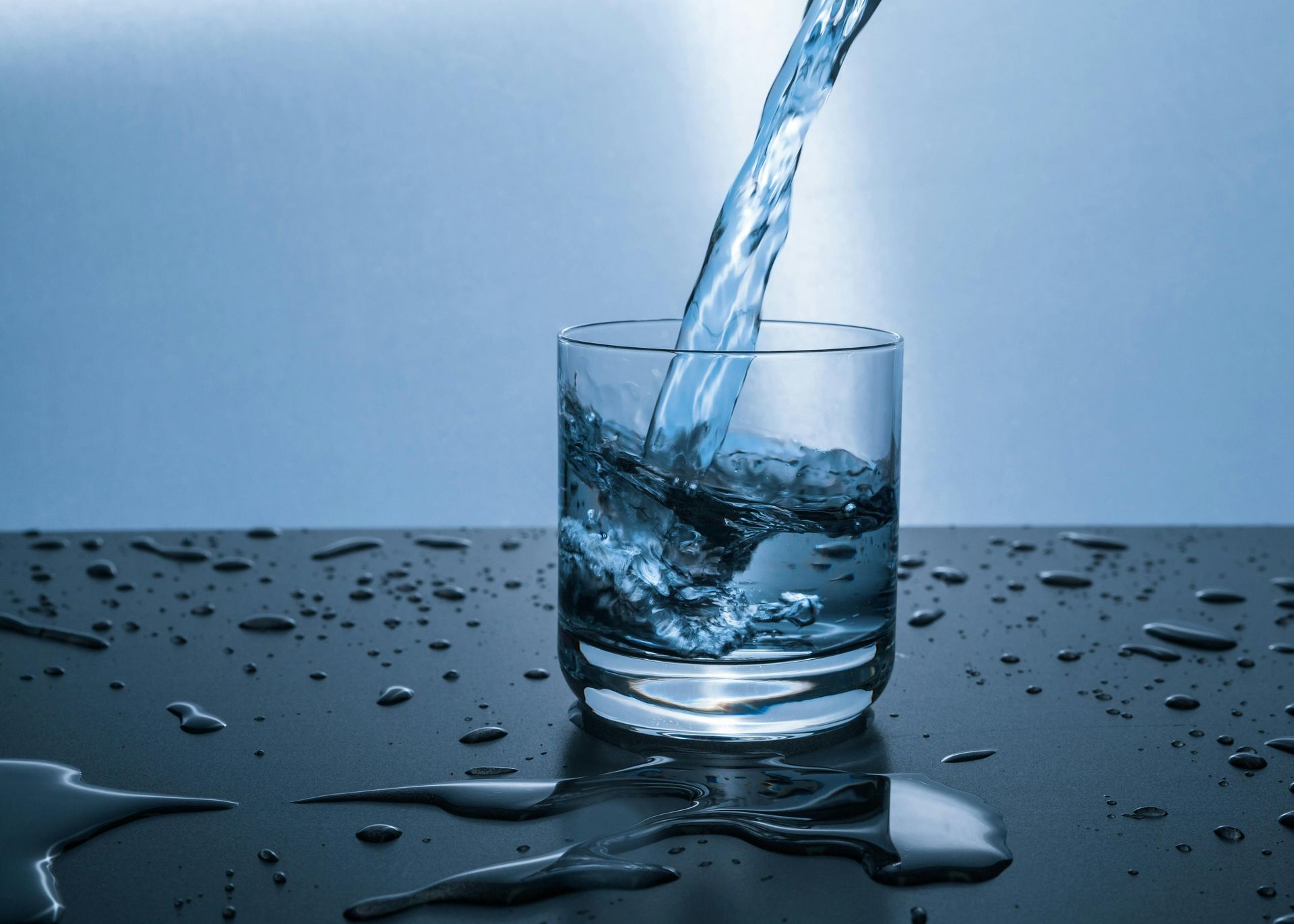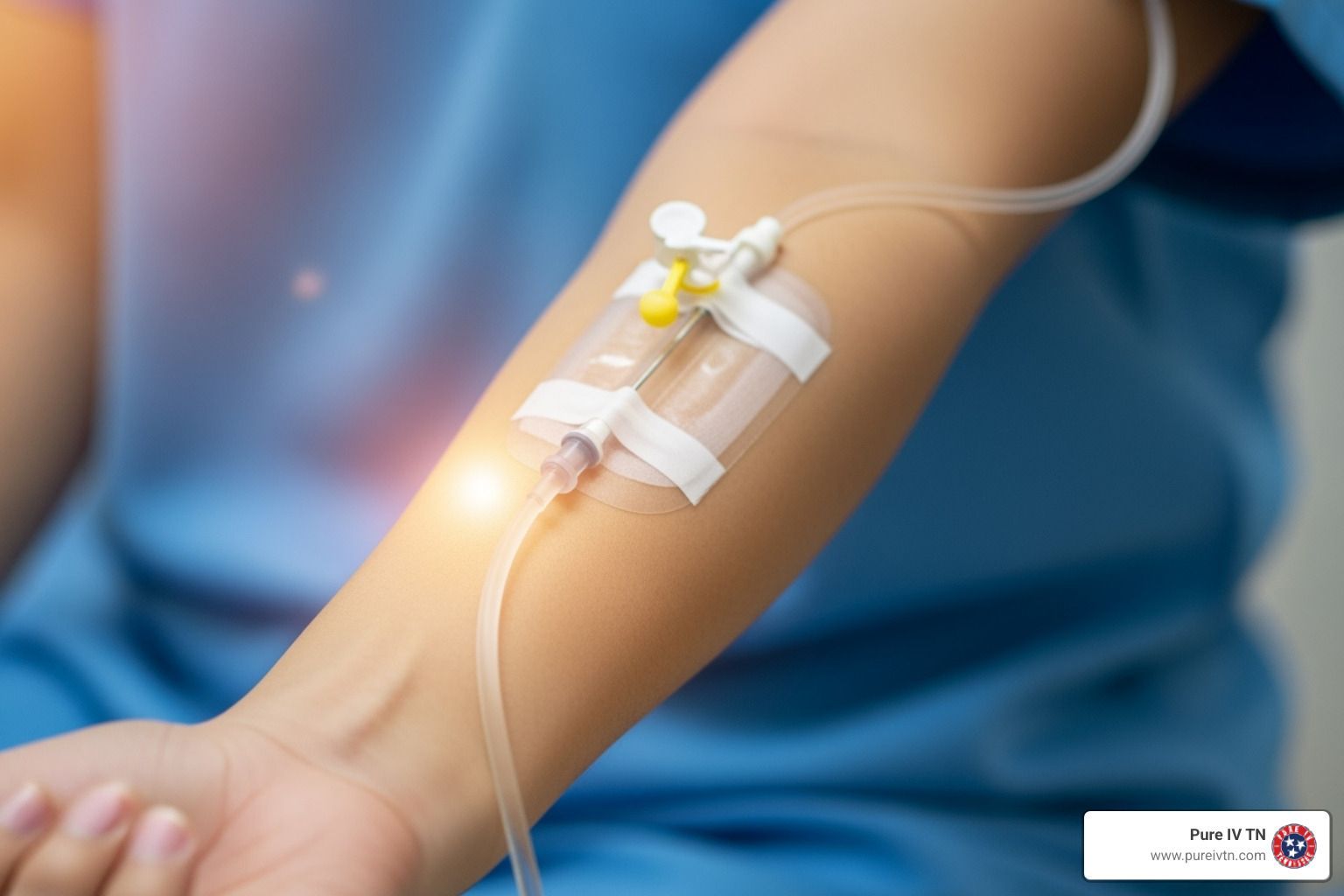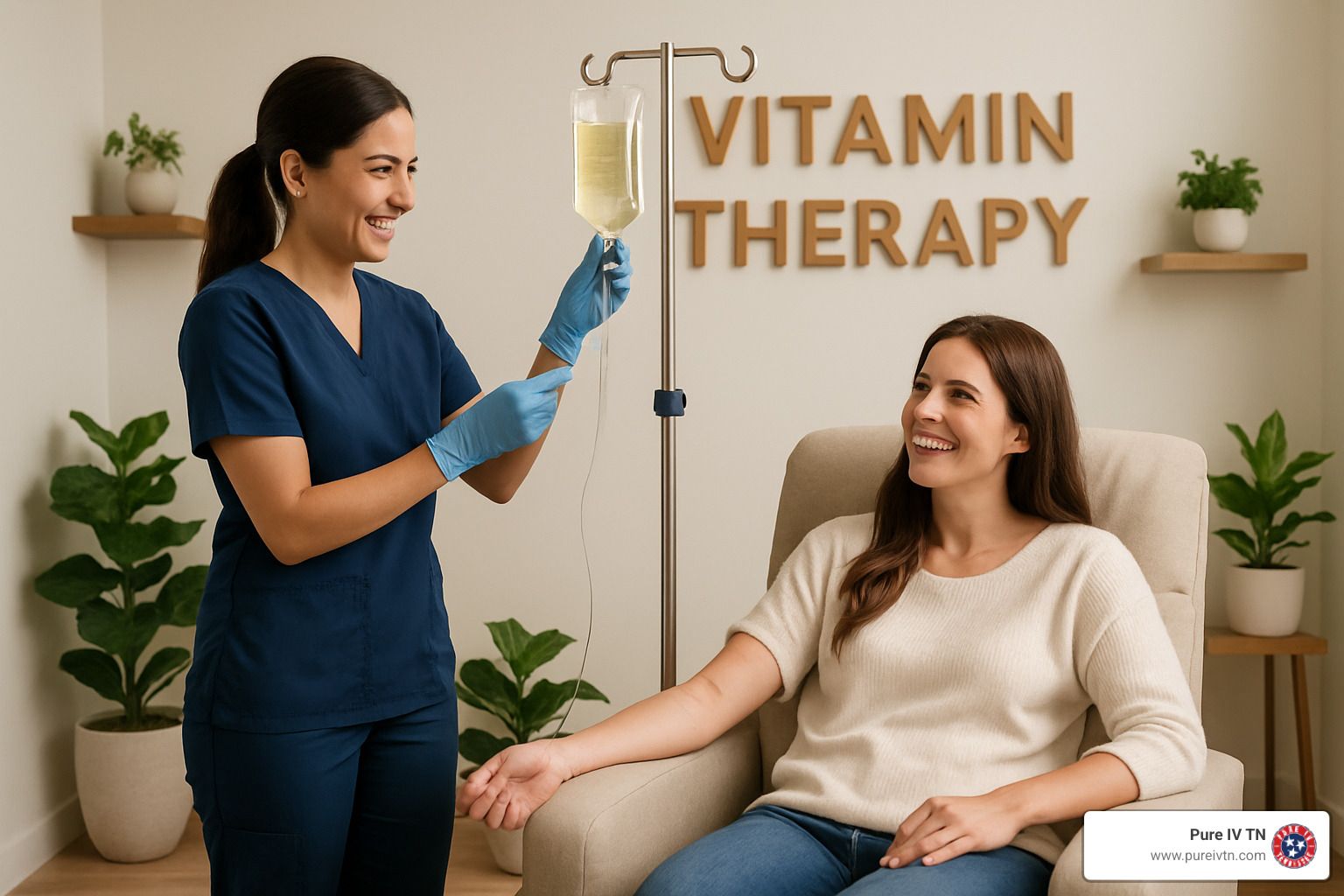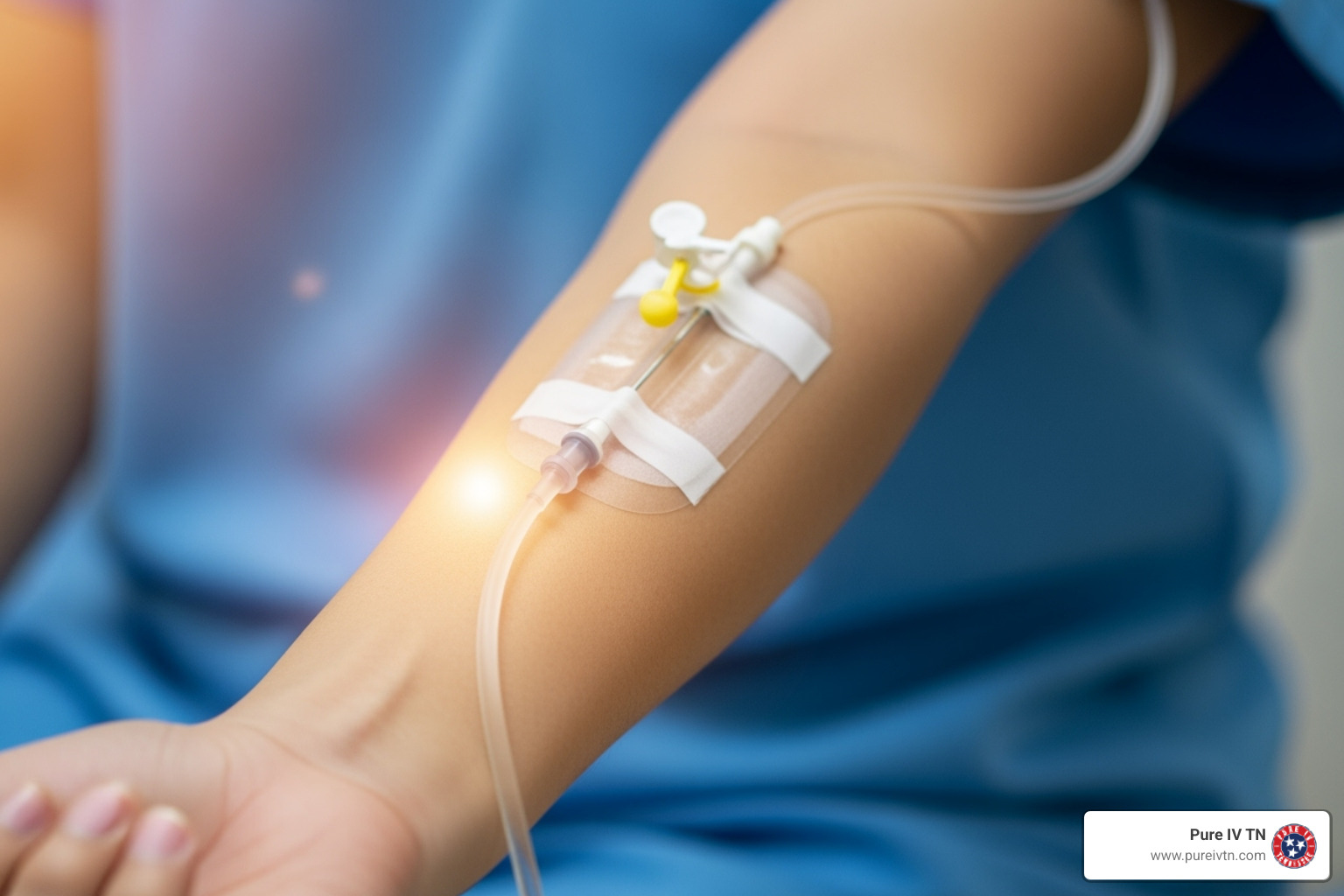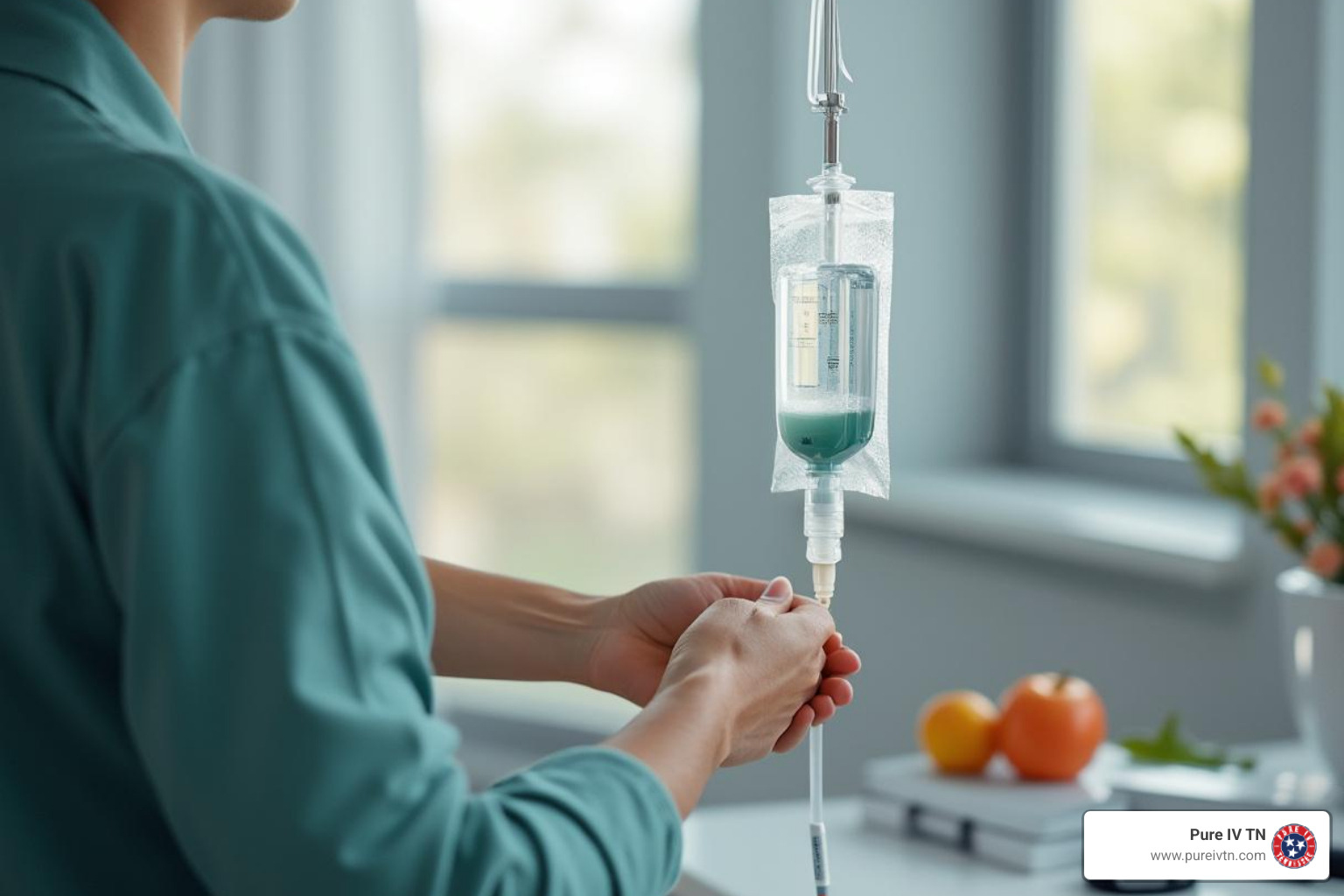Drip, Drip, Hooray! Understanding Intravenous Solutions and Services
Why Intravenous Solutions Are Revolutionizing Modern Healthcare
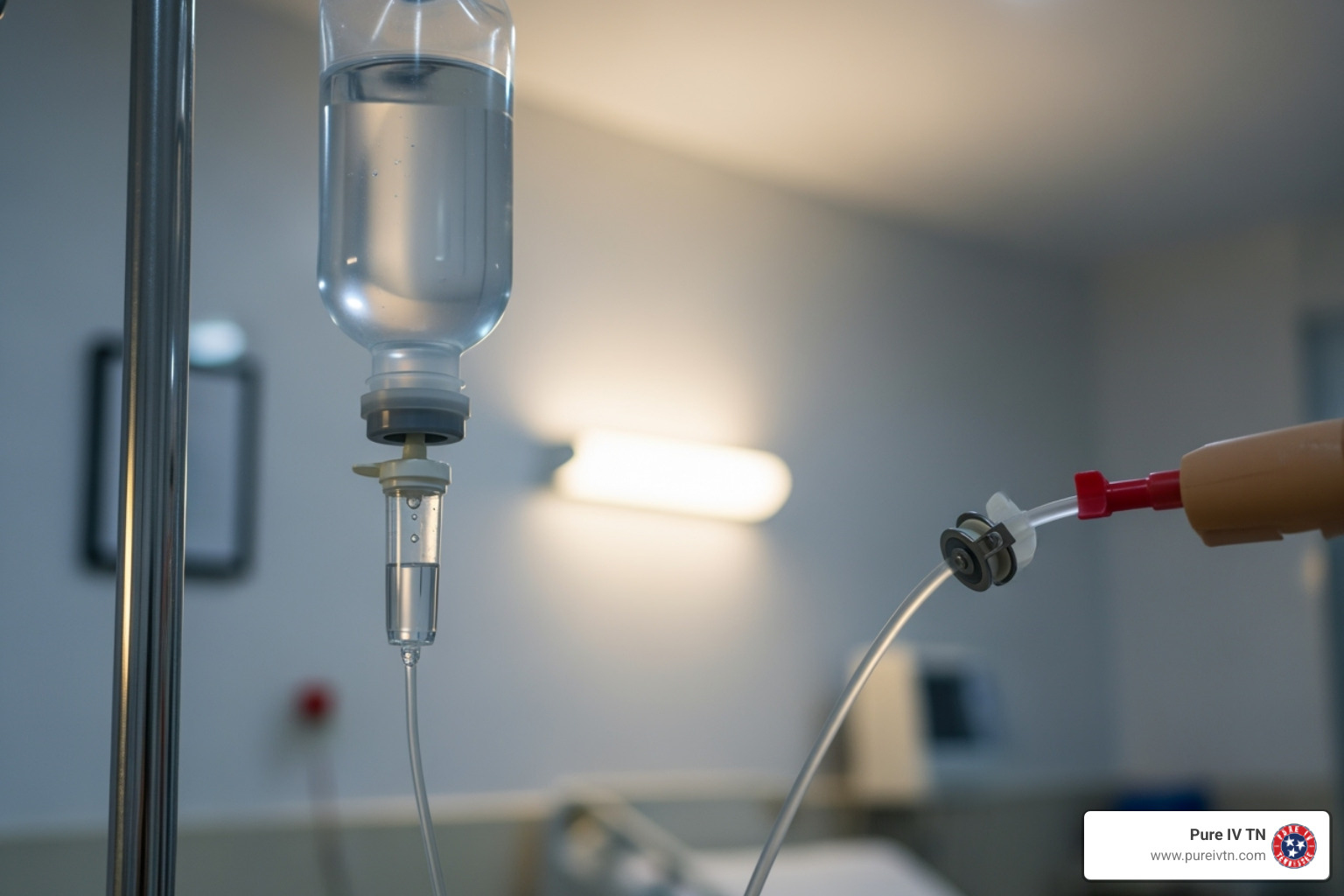
Intravenous solutions are specially formulated fluids delivered directly into your bloodstream through a vein, providing 100% bioavailability for medications, nutrients, and hydration. Here's what you need to know:
Main Types of IV Solutions:
- Crystalloids - Small molecules that cross cell membranes (e.g., Normal Saline, Lactated Ringer's)
- Colloids - Large molecules that remain in blood vessels (e.g., Albumin, blood products)
- Isotonic - Same concentration as blood (e.g., 0.9% Normal Saline)
- Hypotonic - Lower concentration than blood (e.g., 0.45% Normal Saline)
- Hypertonic - Higher concentration than blood (e.g., 3% Sodium Chloride)
Common Uses:
- Fluid resuscitation and dehydration treatment
- Medication delivery and emergency care
- Nutrient supplementation and wellness support
- Athletic recovery and immune system boosting
IV therapy is no longer limited to hospitals. Today, mobile IV services deliver everything from hangover relief to immune support directly to the homes or offices of busy professionals.
Whether you're dealing with severe dehydration, seeking an energy boost, or recovering from illness, understanding your options helps you make informed decisions about your health and wellness.
I'm Joseph Lopez from Pure IV Tennessee, and I've co-founded one of the state's premier mobile IV therapy providers, specializing in delivering personalized intravenous solutions directly to clients across Tennessee. My experience in the mobile IV industry has shown me how convenient access to professional IV therapy can transform people's approach to health and recovery.
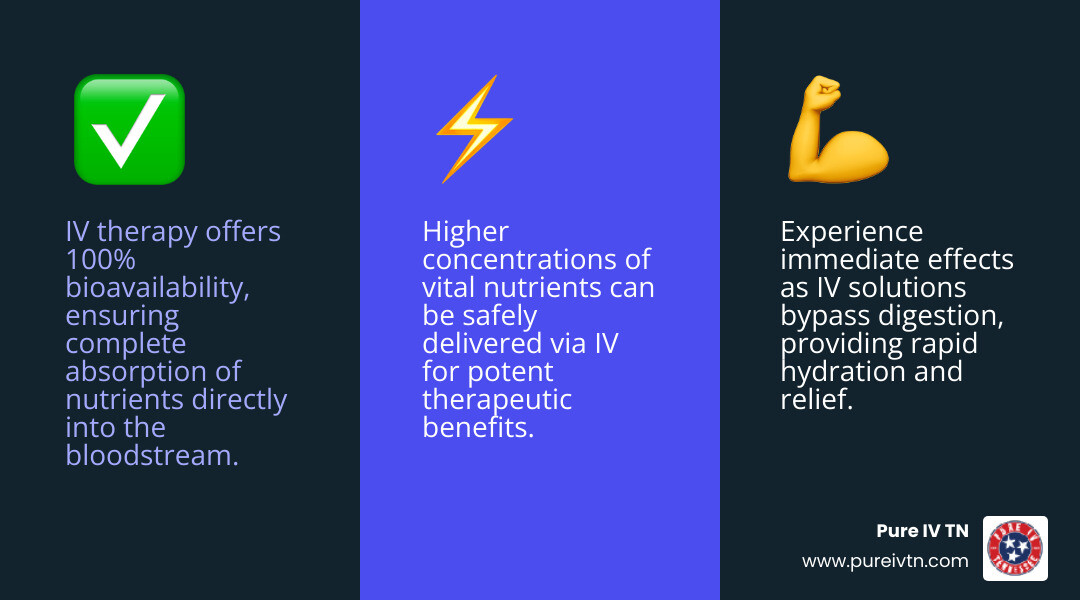
Learn more about intravenous solutions :
The Core Types of Intravenous Solutions
Intravenous solutions are specially designed fluids that work with your body's natural fluid balance. The process of osmosis —the movement of water to balance concentrations—is key. Our bodies have different fluid compartments , including blood plasma and the spaces around cells. How fluid shifts between these compartments determines the correct IV choice.
Broadly, intravenous solutions fall into two main families:
- Crystalloids: These are the most common type of IV fluid. They contain small, dissolved molecules that can easily move between your blood vessels and your cells. Think of them as light, agile solutions. Examples you might hear of include Normal Saline , D5W (dextrose in water), and Lactated Ringer's .
- Colloids: These solutions contain larger molecules that tend to stay put within your blood vessels. They're excellent for boosting blood volume quickly. Examples include Albumin.
Our healthcare providers consider your individual needs to select the precise type, amount, and speed of your IV fluid. This nursing consideration ensures safe, effective care. For a deeper dive, see A guide to IV fluids.
Isotonic Solutions: Restoring Balance
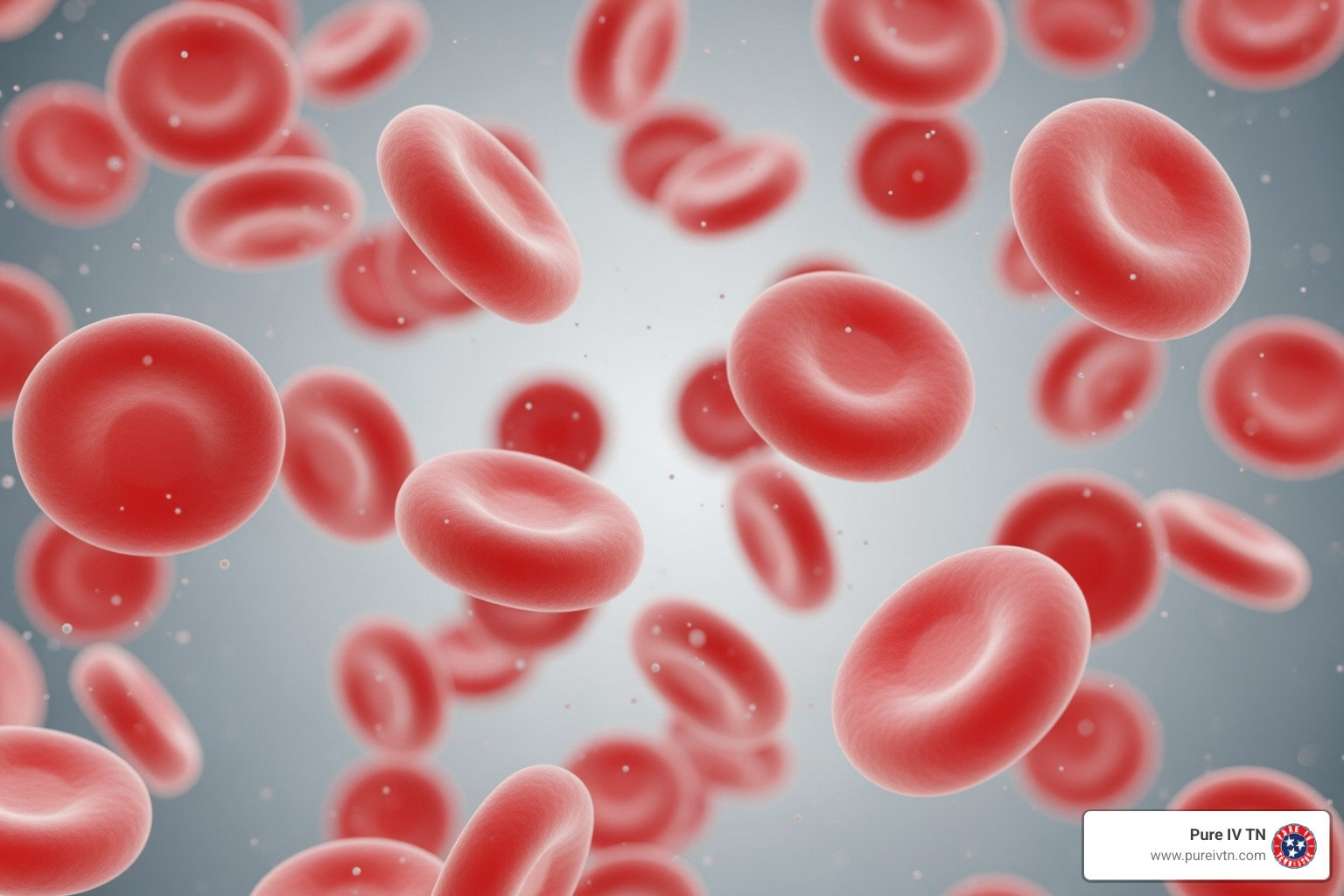
Isotonic solutions have the same particle concentration as your blood plasma. This means there is no fluid shift into or out of your cells. The fluid remains in your blood vessels, boosting blood volume. We use isotonic solutions for hypovolemia (low blood volume) caused by vomiting, diarrhea, or general dehydration . They quickly restore fluids and help raise blood pressure.
Common examples are 0.9% Normal Saline (NS) for general hydration and Lactated Ringer's (LR) , which contains electrolytes and is helpful for surgery or burn patients. We monitor clients closely to ensure safety. Learn more about More info about hydration therapy.
Hypotonic Solutions: Hydrating the Cells
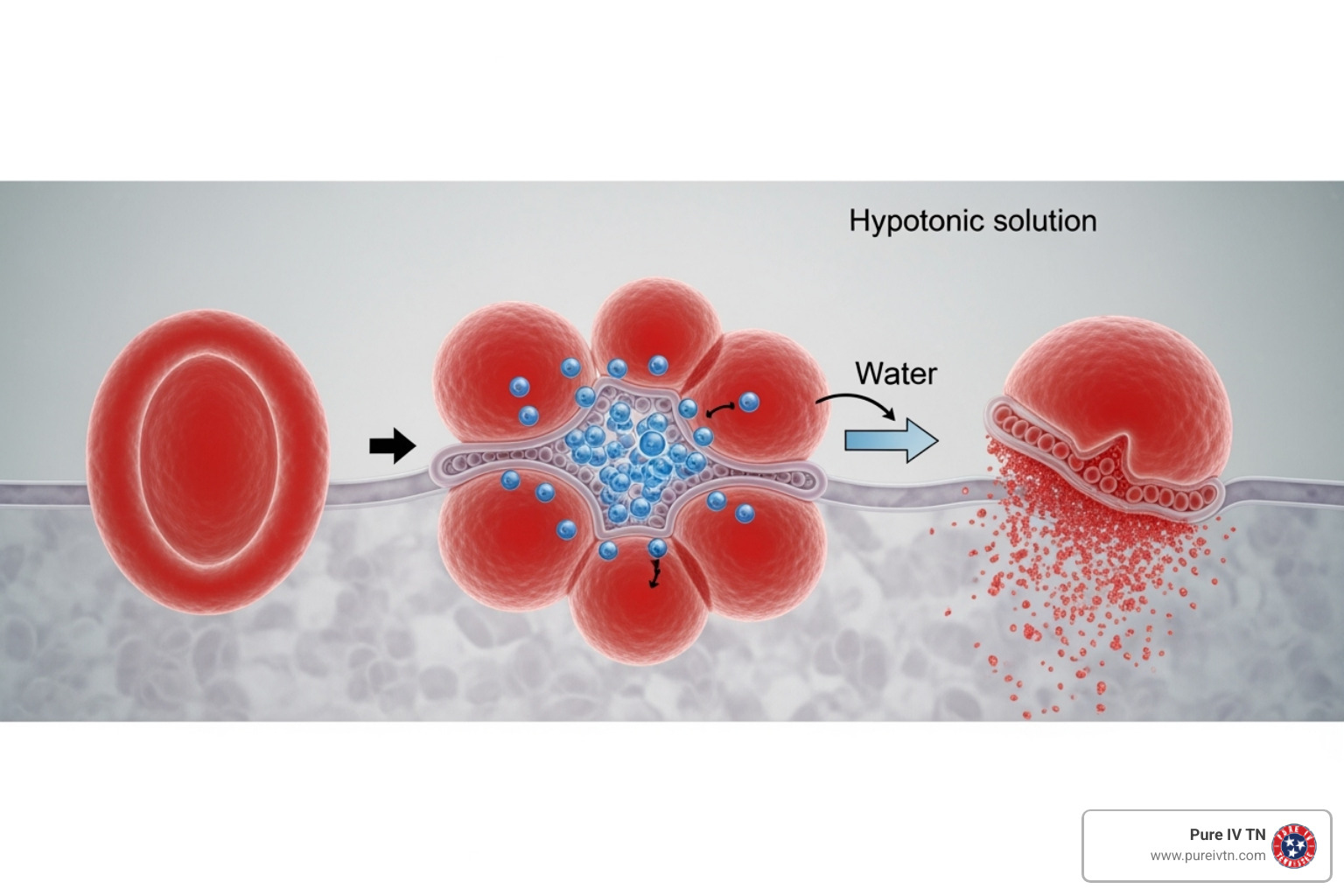
Hypotonic solutions have a lower particle concentration than blood plasma. When administered, water moves from the bloodstream into the cells, hydrating them from the inside out. We use them for intracellular dehydration and hypernatremia (high blood sodium), as they help dilute the sodium.
Examples include 0.45% Normal Saline (1/2 NS) and D5W (Dextrose 5% in water) . D5W is isotonic in the bag, but becomes hypotonic in the body once the dextrose is metabolized, leaving free water to hydrate cells.
These solutions are used with caution, as a rapid fluid shift into cells can cause swelling, particularly in the brain. We carefully monitor clients and avoid these solutions if there's a risk of increased intracranial pressure.
Hypertonic Solutions: Pulling Fluid Out
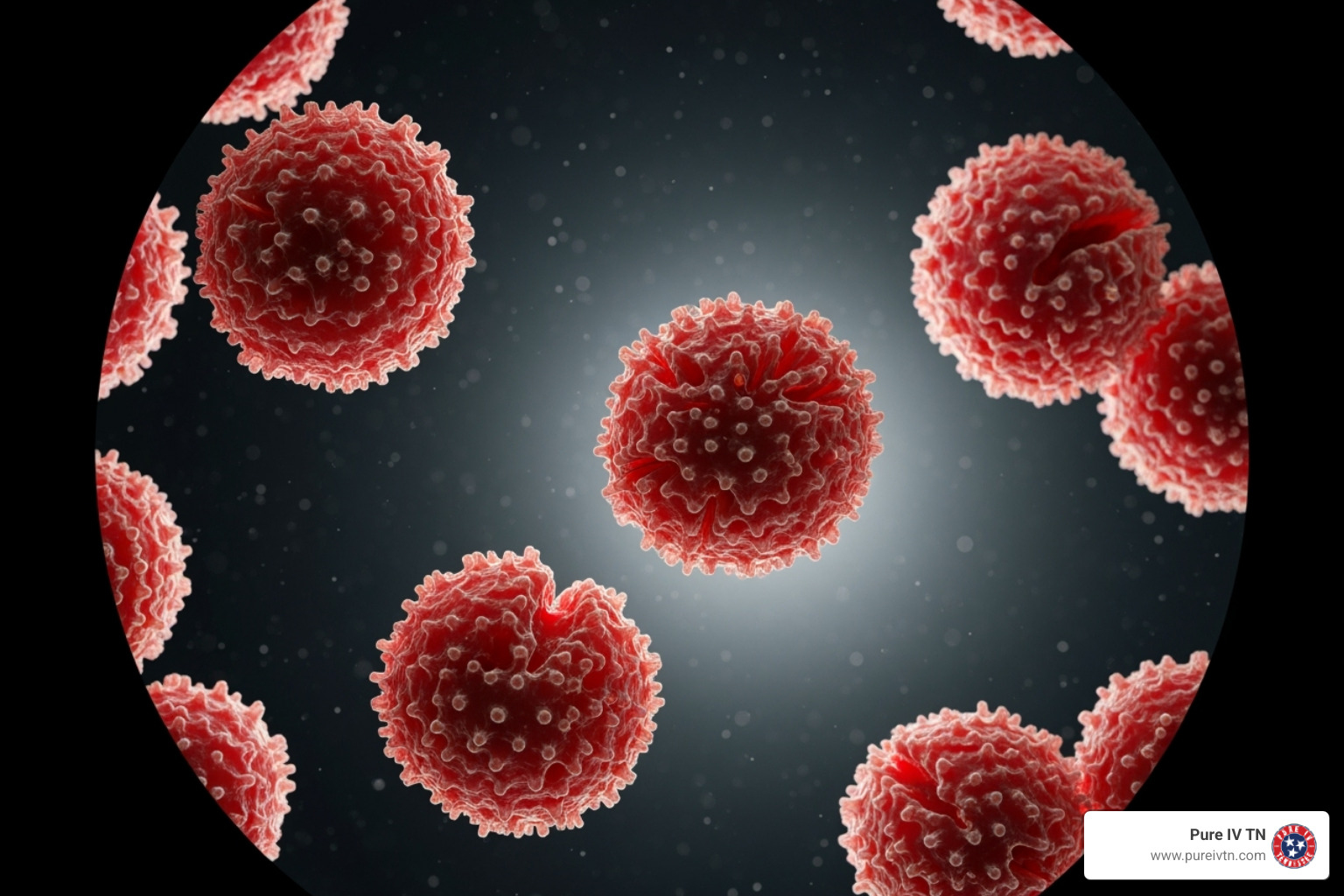
Hypertonic solutions have a higher particle concentration than blood plasma. They pull water out of cells and into blood vessels, increasing blood volume and reducing cellular swelling. These potent solutions are reserved for specific situations, like treating severe hyponatremia (low sodium) or cerebral edema (brain swelling), by moving excess fluid into circulation.
Examples you might encounter include 3% Saline and various Dextrose in Saline combinations like D5 0.45% NaCl or D10W.
Due to their strong effect, hypertonic solutions are administered in controlled settings with close monitoring. We watch for signs of fluid overload and avoid them in clients with heart or kidney conditions that could be worsened. Your safety is our priority.
From Bag to Vein: The IV Therapy Process & Equipment
Receiving intravenous solutions is a precise process handled by our skilled healthcare professionals. We follow a careful procedure to ensure your comfort and safety, delivering beneficial fluids directly into your system.
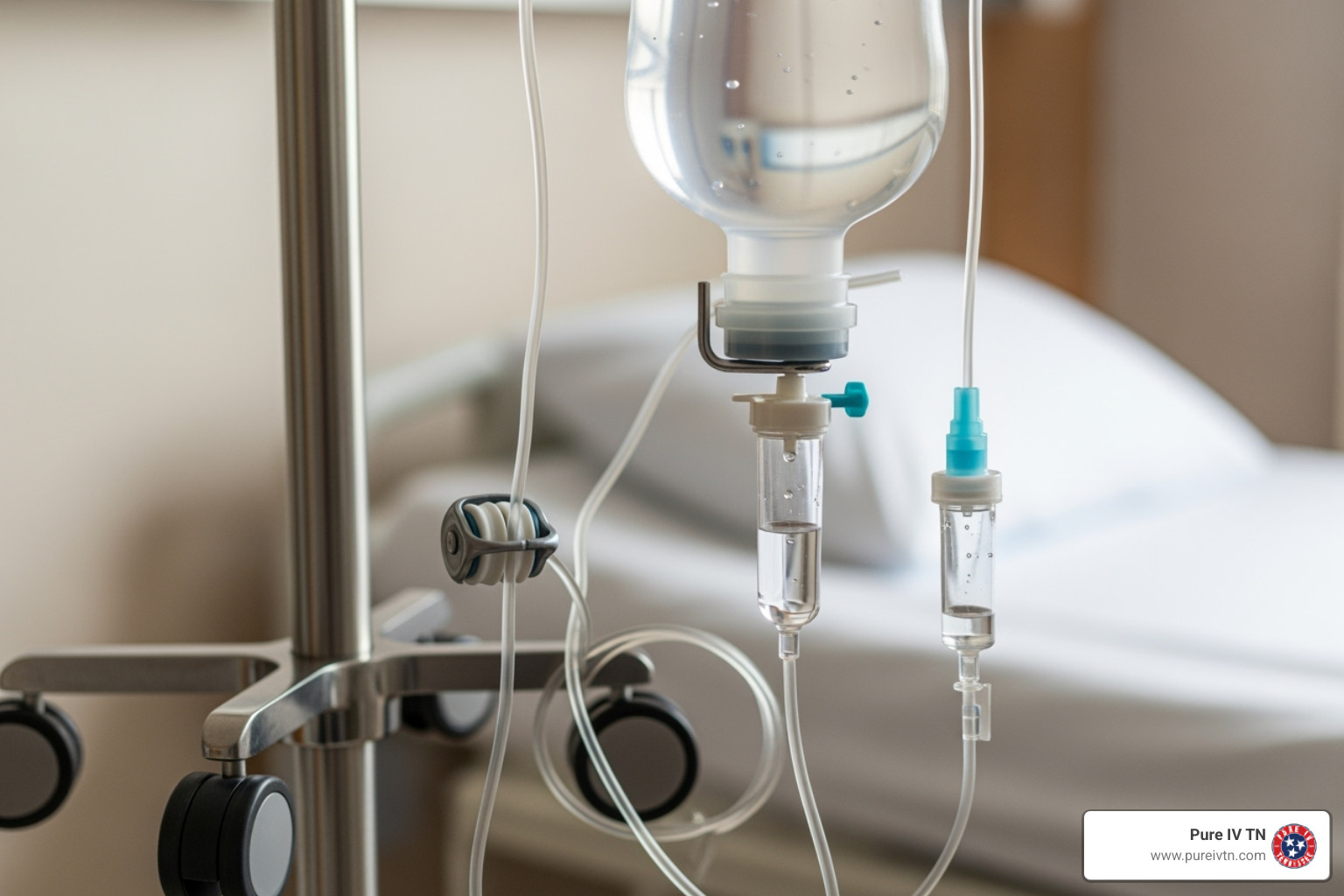
First, our provider determines the correct fluid type and amount for your needs. We then prepare the insertion site by carefully cleaning the skin using strict sterile techniques to prevent infection. A tourniquet is placed on your arm to help locate the best vein. A sterile needle inside a flexible plastic tube (a cannula) is then gently inserted.
The needle is removed, leaving only the soft cannula in your vein. The tourniquet is released, and the cannula is connected to the tubing from the IV bag. We check the flow, secure the cannula with medical tape, and use either an infusion pump for precise control or a gravity drip . We monitor you throughout the session for a smooth experience.
Common Examples of Intravenous Solutions and Their Uses
The world of intravenous solutions is diverse, with each type designed for a specific purpose. Here are some of the most common types we use:
- Normal Saline (0.9% NaCl): A fundamental solution for general hydration and a base for administering medications or blood products.
- Lactated Ringer's (LR) Solution: A balanced electrolyte solution used for fluid loss from burns, trauma, or surgery.
- Dextrose Solutions (e.g., D5W, D10W): Contains sugar (dextrose) and water. D5W treats low blood sugar and provides cellular hydration. Stronger options like D10W offer nutritional support.
- Myers' Cocktail: A popular wellness blend of vitamins and minerals (magnesium, calcium, B vitamins, Vitamin C) to boost energy, support immunity, and combat fatigue. Learn more at Myers' Cocktail IV: The Ultimate Vitamin Infusion.
- NAD+ (Nicotinamide Adenine Dinucleotide): A popular coenzyme infusion for its anti-aging and cellular repair benefits, helping to boost energy and improve cognitive function.
- High-Dose Vitamin C: A powerful antioxidant infusion used to boost the immune system, fight inflammation, and improve skin health.
- Alpha-lipoic Acid: A potent antioxidant used to support nerve health, help manage blood sugar, and reduce cellular stress.
- Glutathione: Known as the "master antioxidant," this infusion is used for detoxification, skin brightening, and immune support.
Each solution is chosen to meet your specific needs for maximum benefit.
Understanding IV Equipment
The safety and effectiveness of intravenous solutions rely on specialized equipment designed for precise, comfortable delivery.
The IV cannula is the small, flexible plastic tube that stays in your vein. Cannula sizes are measured by gauge—the smaller the number, the larger the tube. A larger 16-gauge is used for rapid infusions, while 18- and 20-gauge are common for most therapies. A smaller 22-gauge is used for children or small veins.
The IV bag holds the solution and comes in various sizes (e.g., 1000 cc, 500 cc, 250 cc). The IV tubing connects to the bag and includes a drip chamber to visually monitor the flow. A roller clamp on the tubing allows for manual flow rate adjustment with a gravity drip. For more precise delivery, an infusion pump is used to accurately control the rate.
Understanding this equipment helps explain the professional process. Learn More about what to expect from your first session.
Beyond the Hospital: Modern Uses and Benefits of IV Fluids
Intravenous solutions , once confined to hospitals, now play a role in wellness. Beyond critical care, they are used to boost energy, correct electrolyte imbalances , address nutrient deficiencies , and support chronic conditions , fine-tuning health in a direct, efficient way.
This shift is due to 100% bioavailability; delivering nutrients directly to the bloodstream bypasses the digestive system, leading to faster, more powerful effects than oral supplements. Our mobile services bring these therapies to your doorstep, making optimal health accessible. Learn about The science behind vitamin therapy.
Boosting Immunity and Energy
Our intravenous solutions are excellent for boosting immunity and energy. High-dose Vitamin C infusions support the body's defenses, while B-Complex vitamins (including B12 ) are vital for cellular energy production and combating fatigue.
These infusions are popular before travel or during flu season. Direct delivery to the bloodstream ensures immediate availability to your cells for a quick, potent effect. Explore our IV Treatments: Immune Boost or our NAD+ IV Therapy: Anti-Aging & Brain Boosting Benefits to revitalize from the inside out.
Enhancing Athletic Performance and Recovery
For athletes, intravenous solutions are a game-changer for performance and recovery. After intense workouts, specialized IV drips offer rapid rehydration post-exercise , replenishing fluids and electrolytes faster than drinking water.
We add amino acids for muscle repair and magnesium for muscle function and cramp relief. By reducing inflammation and speeding cellular recovery, these infusions help you bounce back faster. See how we can help with our IV Treatments: Athletic Recovery.
Migraine Relief and Aesthetic Improvement
Intravenous solutions also offer targeted relief and aesthetic benefits. For migraine sufferers, our specialized drips provide fast-acting migraine treatment by delivering anti-inflammatory and anti-nausea medication directly to the bloodstream. This bypasses the digestive system for quicker relief than oral medications. Find details at IV Therapy for Migraines and Headaches.
IV therapy also improves your external radiance. Proper hydration for beauty is key for healthy skin, hair, and nails. Our beauty-focused drips deliver a glow from within, often including antioxidants like Glutathione for skin brightening and Biotin for hair and nail strength. These infusions combat aging and environmental stress, leaving you refreshed. Explore our IV Treatments: Beauty.
Safety First: Understanding Risks and Complications
While intravenous solutions offer many benefits, your safety is our top priority. IV therapy requires specialized knowledge and strict protocols. Every session is performed by a licensed registered nurse (RN) under the medical guidance of experienced physicians, ensuring professional care and patient monitoring .
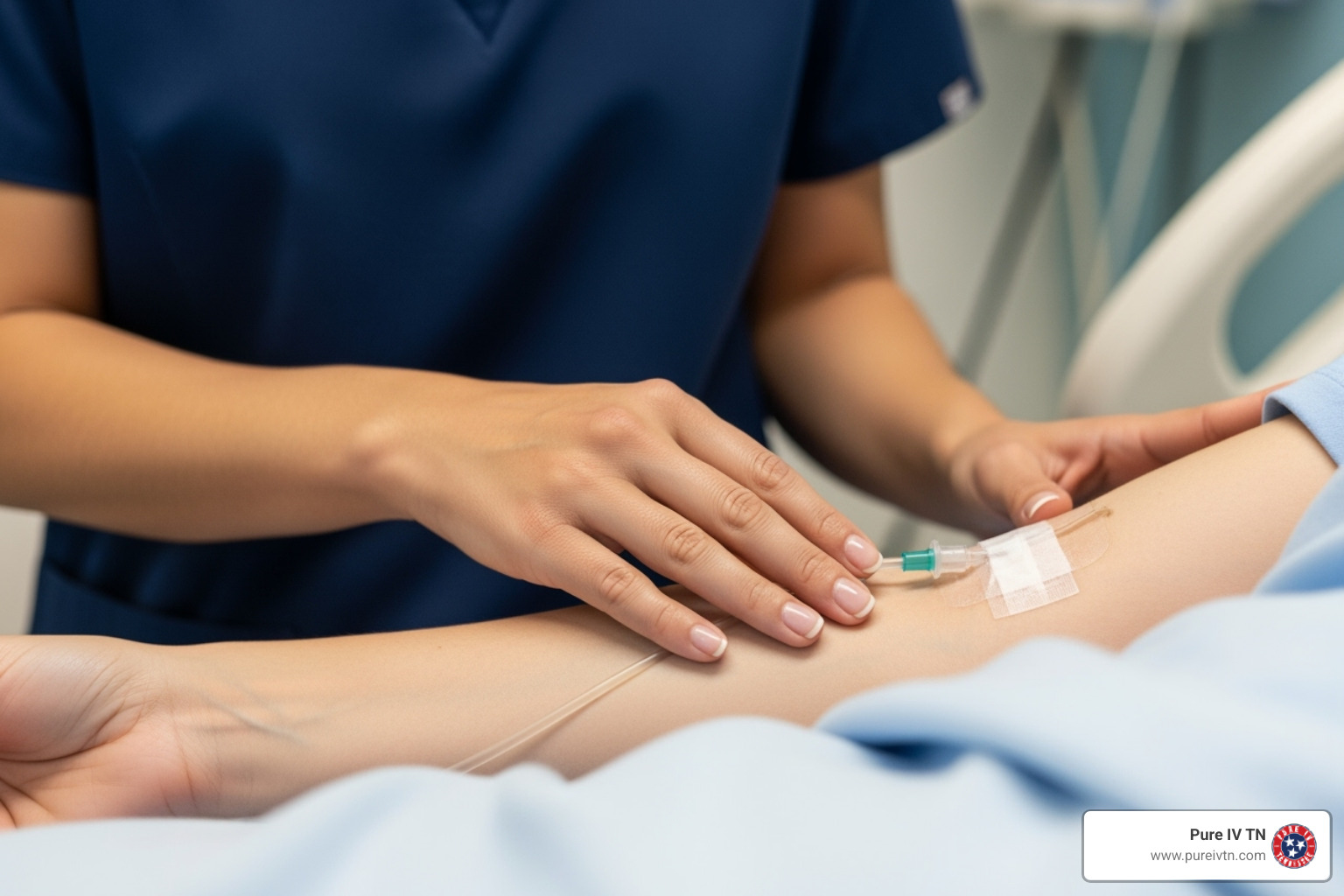
Choosing a qualified provider like Pure IV TN is crucial. We adhere to the highest medical standards for safe, effective treatment. For more on this topic, see this Review of IV fluid management in adults.
Potential Risks of Intravenous Solutions
Even with a careful approach, any procedure that breaks the skin has potential, though rare, risks:
- Infection: A small risk exists at the insertion site. We minimize this with strict sterile procedures.
- Phlebitis: Vein inflammation, causing redness, warmth, or pain along the vein.
- Infiltration and Extravasation: Infiltration is when fluid leaks into surrounding tissue. Extravasation is a more serious form where the fluid can damage tissue.
- Fluid Overload (Hypervolemia): Giving too much fluid, especially to those with heart or kidney issues, can cause swelling, shortness of breath, or high blood pressure.
- Electrolyte Imbalance: Incorrect fluid choice or administration can cause an electrolyte imbalance .
- Air Embolism: A rare but serious risk where air enters the bloodstream. Our careful procedures minimize this risk.
- Allergic Reactions: A rare reaction to the solution or medication. We review your allergy and health history beforehand.
We take every precaution to minimize these risks for a safe and beneficial experience.
Nursing and Patient Considerations
Our commitment to your well-being is paramount. The importance of sterile technique cannot be overstated. From skin preparation to using sterile equipment, every step is performed with care to prevent infection.
Our nurses are constantly monitoring for complications during your session. They watch the IV site for irritation or leakage and check for signs of fluid imbalance. Monitoring your comfort and vital signs is standard procedure.
For longer-term therapy, site rotation (moving the IV site every 72-96 hours) is a key step to reduce complication risks.
Clear client communication is essential. We explain the process, answer questions, and ensure you are comfortable. We also advise on when to alert a healthcare provider about any post-session concerns. Your safety and satisfaction are our priority. Learn more about the Benefits of Mobile IV Therapy.
A Brief History of Intravenous Therapy
The journey of intravenous solutions from early experiments to modern medical tools is a testament to medical ingenuity. The concept dates back to the 17th century. In 1656, Sir Christopher Wren and Robert Boyle conducted early experiments , injecting substances into veins. These initial attempts laid the groundwork for future developments.
IV therapy took a scientific turn in the 19th century during the cholera epidemics . In the 1830s, Scottish physician Dr. Thomas Latta successfully revived dehydrated patients with intravenous saline, demonstrating the life-saving potential of intravenous solutions .
The 20th century brought modern advancements , including a better understanding of electrolyte balance and refined development of saline solutions . A key innovation was the shift from glass bottles to plastic bags in the 1970s and 80s, making IV therapy safer, more accessible, and easier to administer.
Today, thanks to this history, intravenous solutions are a sophisticated tool in healthcare, constantly evolving to meet medical needs and support overall wellness.
Conclusion: The Future of Hydration is Here
What began as a hospital necessity has become a personal and accessible wellness tool. We've explored how intravenous solutions work, from isotonic solutions that restore balance to hypotonic and hypertonic fluids that manage cellular hydration.
IV therapy now bridges the gap between feeling okay and feeling vibrant. For athletes, professionals, or anyone facing wellness challenges, intravenous solutions offer 100% absorption, a benefit oral supplements cannot match.
The move from hospitals to mobile services at your doorstep is a fundamental change in health management. You can now proactively support your immune system, speed up recovery, and reduce stress from the comfort of your home, without needing to be critically ill.
The future of intravenous solutions lies in their personalization and accessibility. Our ability to customize treatments ensures you receive exactly what your body needs, delivered by experienced professionals who understand the science of wellness.
For those seeking professional and convenient care, mobile services like Pure IV TN bring customized wellness solutions directly to your location, making optimal health more accessible than ever. Explore IV Therapy in Franklin, TN to see how we can help you feel your absolute best.
